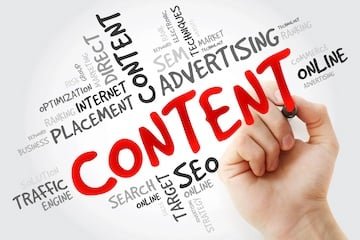Optimizing content for organic rankings involves editing text and other on-page elements for the words and concepts people use when searching. The effectiveness of those keywords depends on how and where they appear on a page.
The checklist below will help ensure maximum keyword prominence to search engines.
Content Optimization Checklist
Title tag
A title tag is an HTML element that provides a concise and informative description of a web page. This title shows in browser tabs but is not immediately visible to a web user.
Search engines rely on title tags to determine the page’s contextual and keyword relevance. It’s the most essential element for rankings and often included by search engines in visible organic snippets. Thus a title tag should appeal to both humans and search algorithms.

Sample title tag: “Practical Ecommerce | News, How to, Definitions, Guides, Examples.” Click image to enlarge.
Here’s Practical Ecommerce’s home page title tag used as the link in Google’s organic search snippet.
Only the first 60 characters (or so) of a title tag will show in a snippet. Hence ensure those words invite (human) clicks, although Google will evaluate the full title as a ranking signal. Still, don’t overuse keywords.
Meta description
A meta description is an HTML attribute that summarizes a page. It is not visible to visitors, but search engines frequently show it in organic results below the title.

Sample meta description: “Practical Ecommerce: Independent analysis and strategy for online merchants — Amazon, SEO, analytics, marketing, design, payments, social media, cross-border, multichannel, shipping, much more.” Click image to enlarge.
Here’s Practical Ecommerce’s home page meta description used by Google in search results.

The meta description for Practical Ecommerce’s home page in Google’s search results. Click image to enlarge.
Meta descriptions are not ranking signals but can influence searchers’ decisions to click the listing in organic results.
Words that people use in a search are bolded in the description of the search snippet, as shown above with the query “practical ecommerce.” Thus including searchers’ terms in the meta descriptions is important for clicks, as are calls to action.
Google shows only the first 150 characters (or so) of meta descriptions in search results, although it experiments continually with that length.
H1 headline
The H1 HTML tag defines the most important heading of a page. Google often shows it in search snippets instead of the title tag, and it’s visible and dominant to page visitors.
Use similar writing principles for H1 tags as for titles, but keep in mind an H1 could impact visitors’ engagement, a ranking factor. Thus compose H1 headings to entice visitors to read and scroll on a page.
Body copy
The body copy is why visitors access a page. Use keywords naturally in language that reads well. The beginning is more critical than the end. Forget about keyword density. The more natural the copy, the better.
In an era of AI search, include question and conversational words, related terms, and intent-based keywords, such as:
- Informational: How to repair drywall.
- Commercial: Best laptop for teenagers.
- Transactional: Lowest price for a MacBook Air.
I’ve addressed tools and resources for AI search.
H2 and H3 subheadings
H2 and H3 subheadings help Google and humans understand a page’s structure. They also improve visitor engagement by making it easier to skim and find what’s helpful.
Use keywords in subheadings, but don’t overdo it. Like anything on the page, subheadings should be natural.
Internal and external linking
Contextual linking — linking from body copy — sends a stronger ranking signal than linking from the navigation menus. Always include internal links to related content (and products). External links to trusted sources and related tools are helpful, too.
Both internal and external links help Google understand the relevancy of a page.





